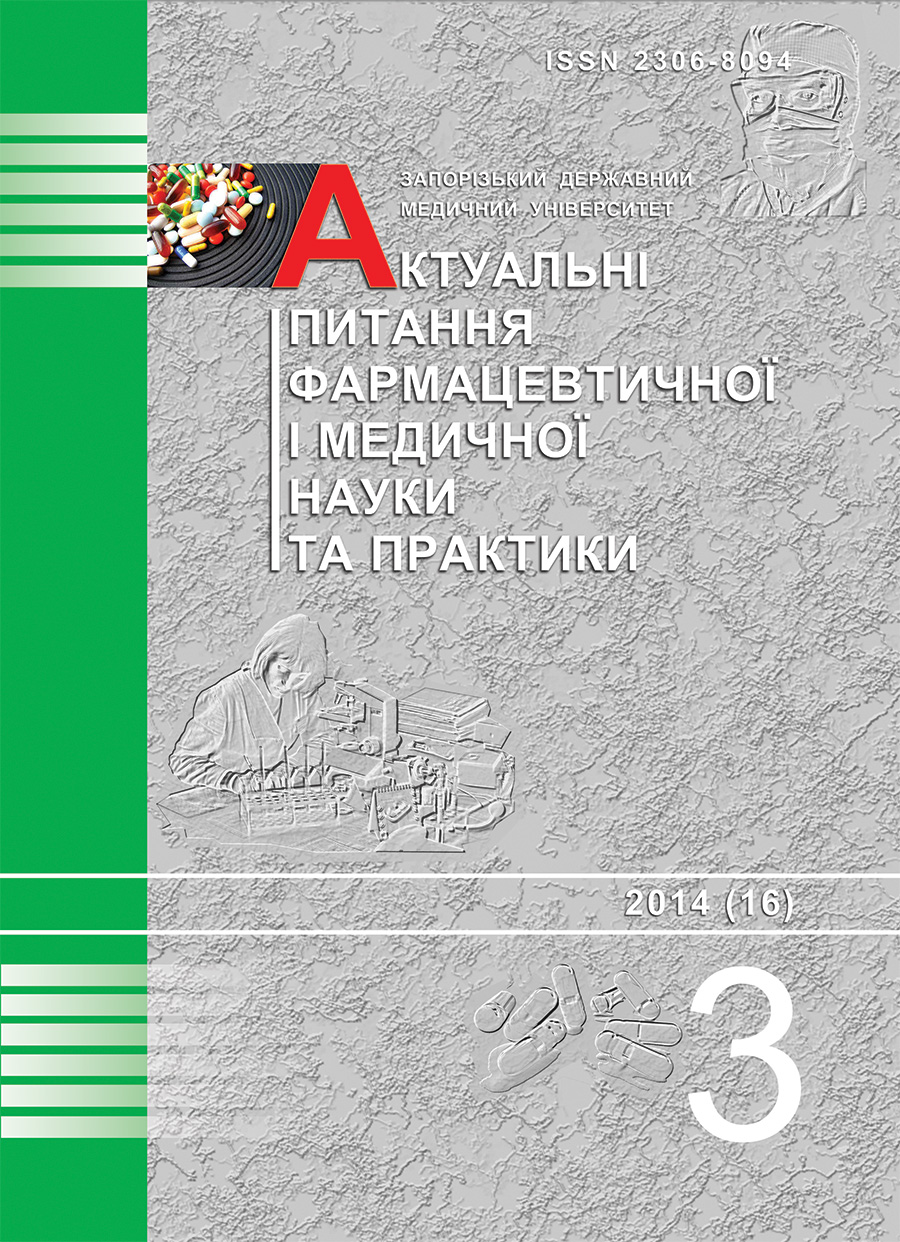NEW POSSIBILITIES OF STAPHYLOCOCC INFECTION THERAPY
DOI:
https://doi.org/10.14739/2409-2932.2014.3.34045Keywords:
Staphylococcus aureus, coordinative compounds of metals, antimicrobic effectAbstract
Introduction. Staphylococcus cause wide range of diseases ranging from mild skin infections to severe neuroinfections. So far, it is one of the four most common causes of nosocomial infections. Emergence and widespread resistance to various forms of medicines for staphylococci is more characteristic than for any other bacteria species. Therefore there is a need to develop new drugs to combat the pathogen, which can be used for effective treatment of infections caused by Staphylococcus aureus. At the Department of General Chemistry and Polymers Odessa I.I. Mechnikov National University different metal (Mg, Co) bis (citrate) germanates (stanates) - coordination compounds have been synthesized. Their molecules contain three bioactive components, such as citric acid residue (H4Citr); ions Ge4+ or Sn4+; Mg2+ or Co2+: [Mg(H2O)6][Ge(HCitr)2]·4H2O (germacit); [Co(H2O)6][Ge(HCitr)2]·4H2O (gercocit); [Mg(H2O)6][Sn(HCitr)2]·4H2O (stanmacit); [Co(H2O)6][Sn(HCitr)2]·4H2O (stancocit). Screening studies have shown that these compounds have neurotropic properties and both show antistaphylococcal activity.
The aim of research is the investigation of influence of new coordinative metal compounds, namely germacit, gercocit, stanmacit and stancocit on Staphylococcus aureus different strains’ growth in case of their separate and combined administration with benzylpenicillin-sodium on nutrient broth.
Materials and methods. Experiments were performed on Staphylococcus aureus АТСС 25923, Staphylococcus aureus 2781, Staphylococcus aureus Kunda strains. We determined minimal inhibitory concentration (MIC) for metal complexes, benzylpenicillin sodium and antibacterial activity in the joint application of biologically active compounds at the same concentrations and benzylpenicillin sodium (BPN) in nutrient broth. Results’ accounting was performed using the values of optical density slurries in units of Mac Farland (McF). Experiments were carried out 3-5 reps. Results were treated statistically using computer programs Microsoft Excel 2007.
Results. Gercocit (final concentration of 400 µg/ml) and BPN (final concentration of 0.05 and 0.025 µg/ml) combined administration suppressed the growth of S. aureus ATCC 25923 at 81.08%. Potentiation effect has been observed. Concomitant administration of gercocit in concentration of 800.0 µg/ml and BPN in 10.0 µg/ml significantly suppressed the growth of S. aureus Kunda culture at 84.64%, but the combined effect of compounds on S. aureus 2781 was at the level of influence of gercocit.
Combined stancocit and BPN administration failed to reveal the significant growth inhibition of S. aureus ATCC 25923 and S. aureus 2781 strains. Stancocit in concentration of 800.0 µg/ml and BPN in 10.0 µg/ml inhibited the growth of compatible strain S. aureus Kunda on 76, 43%.
Conclusion. The suppression of Staphylococcus aureus ATCC 25923 and Staphylococcus aureus Kunda strains growth has been observed in case of germanium coordinative compounds with cobalt and citric acid combined administration with BPN in greater extent pertaining each compound separate use (the effect of potentiation). Both stancocit and BPN combined administration resulted in potentiation of their effect against Staphylococcus aureus Kunda. Substitution of stanum on germanium led to decrease in the activity of antistaphylococcal compounds.
Thus, we can conclude that the considered coordination compounds are promising antistaphylococc drugs and require further study to combined application of the known antibiotics to treat infections caused by resistant strains of pathogens.
References
Vengerov, Yu. Ya., Nagibina, M. V., Chencov, V. В., Smirnova, T. Yu., Molotilova, T. N., Kryuchkova, T. V., et al. (2008). Aktual'nye problemy diagnostiki i lecheniya [Actual problems of diagnosis and treatment of pectoralis]. Lechaschij vrach, 9, 31–36. [in Russian].
Lobzin, Yu. V., Pilipenko, V. V., Karev, V. E (2010). Bakterial'nye meningity i gerpeticheskaya infekciya [Bacterial meningitis and herpes virus infection]. Infekcionnye bolezni, 8(4), 5–9. [in Russian].
Coculescu, B. I. (2009). Antimicrobial resistance induced by genetic changes. J Med Life, 2, 114–123.
Conly, J. (2010). Rezistentnost' k protivomikrobnym preparatam: povtorenie «tragedii obschego dostoyaniya» [Antimicrobial resistance: the repetition of «the tragedy of the commons»]. Byulleten' Vsemirnoj organizacii zdravookhraneniya, 88(11), 797–876.
(2001) Global Strategy for Contaiment of Antimicrobial resistance. Bulletin of the World Health Organization. WHO. WHO/CDS/CSR/DRS/2001. Geneva.
Kirienko, O. S., Mosiyanc, V. G., & Pogosova, M. A. (2007) Iskhody gnojnykh meningitov u detej [Outcomes of purulent meningitis in children]. «Actual issues of infectious disease and vaccination», Proceedings of the VI Congress of Russian children ifektsionistov, (p. 83). Moskow. [in Russian].
Marcsinko, E. E`., Minacheva, L. H., Pesaroglo, A. G., Sejfullina, I. I., Churakov, A. V., & Sergienko, V. S. (2011). Bis(citrato)germanaty dvukhvalentnykh 3d-metallov (Fe, Co, Ni, Cu, Zn). Kristallicheskaya i molekulyarnaya struktura [Fe(H2O)6][Ge(НCit)2]4H2O [Bis (citrate) 3d-germanates divalent metals (Fe, Co, Ni, Cu, Zn). The crystal and molecular structure of [Fe (H2O)6] [Ge (NCit)2] 4H2O]. Zhurnal neorganicheskoj khimii, 56(8), 1247–1253. [in Russian].
Marcsinko, E. E`., Minacheva, L. H., Chebanenko, E. A., Sejfullina, I. I., Churakov, A. V., & Sergienko, V. S. (2013). Usloviya obrazovaniya geterometallicheskikh kompleksov v sistemakh GeCl4 (SnCl4) – limonnaya kislota – M(CH3COO)2 – H2O. Kristallicheskaya i molekulyarnaya struktura [M(H2O)6][Ge(НCit)2]4H2O (M = Mg, Mn, Co, Cu, Zn) и [M(H2O)6][Sn(НCit)2]4H2O (M= Mg, Co, Ni) [Conditions for the formation of heterometallic complexes in systems GeCl4 (SnCl4) - citric acid - M (CH3COO) 2 - H2O. Crystal and molecular structure of [M(H2O)6][Ge(НCit)2]4H2O (M = Mg, Mn, Co, Cu, Zn) and [M(H2O)6][Sn(НCit)2]4H2O (M= Mg, Co, Ni)]. Zhurnal neorganicheskoj khimii, 58(5), 588–595. [in Russian].
Matiushkina, M. V., Hridina, T. L., Shemonayeva, K. F. (2013). Antymikrobni vlastyvosti koordynatsijnoj spoluky hermaniiu z kobaltom ta lymonnoiu kyslotoiu [Antimicrobial properties of coordination compounds of cobalt and germanium and citric acid]. Klinicheskaya farmakologiya i farmakoterapiya zabolevanij v svete dokazatel'noj mediciny Abstracts of Papers of the 7th Scientific and Praktscal Conference with international participation, (p. 98–99). Vinnitsa. [in Ukrainian].
(2007) Nakaz Ministerstva okhorony zdorovia Ukrainy Pro zatverdzhennia metodychnyhk vkazivok «Vyznachennia chutlyvosti mikroorhanizmiv do antybakterialnyhk preparativ» : vid 5 April 2007 roku. № 167/2007 [The approved guidelines on «Determination of the sensitivity of microorganisms to antibiotics»]. Novosti mediciny i farmacii, 18(225). [in Ukrainian].
Downloads
How to Cite
Issue
Section
License
Authors who publish with this journal retain copyright and grant the journal right of first publication with the work simultaneously licensed under a Creative Commons Attribution License that allows others to share the work with an acknowledgement of the work's authorship and initial publication in this journal.


